OSHA Fire Extinguisher Signs A Comprehensive Guide
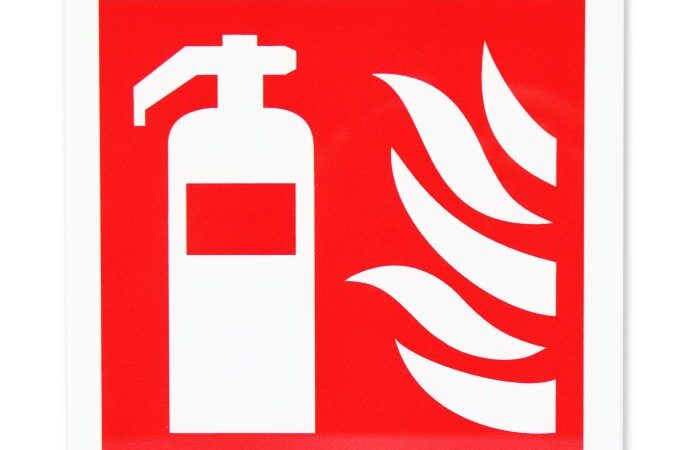
OSHA Fire Extinguisher Signs: Knowing where they are and what they mean is crucial for workplace safety. This guide breaks down OSHA’s regulations, sign types, placement, maintenance, design, and accessibility considerations. We’ll explore the specific standards, penalties for non-compliance, and best practices for ensuring your fire extinguishers are clearly and correctly marked, keeping your workplace safe and compliant.
From understanding the different types of signs—location, type designation, and maintenance—to mastering optimal placement and visibility, we’ll cover everything you need to know. We’ll even delve into the importance of accessible signage for individuals with disabilities, ensuring everyone is informed and prepared in case of a fire emergency.
OSHA Regulations on Fire Extinguisher Signage
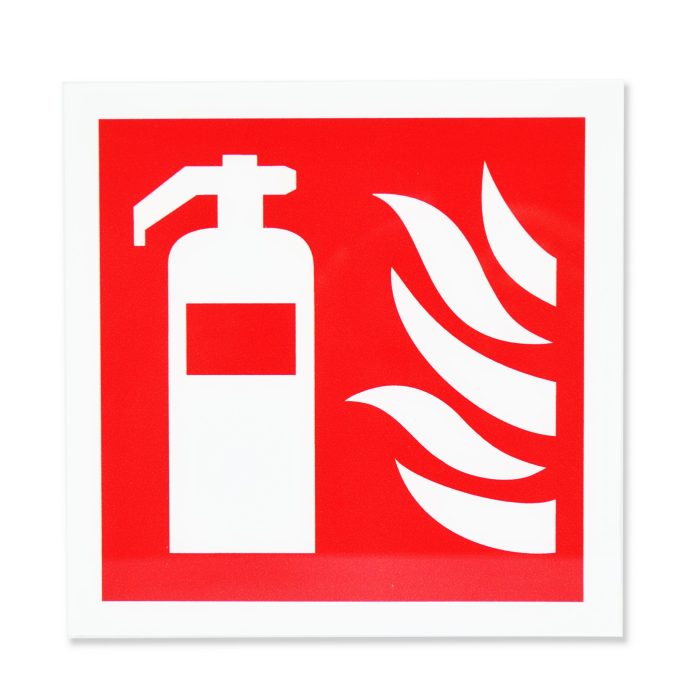
Source: safety signs.sg
OSHA regulations concerning fire extinguisher signage are crucial for workplace safety. Properly placed and visible signage ensures employees can quickly locate and use fire extinguishers in emergencies, potentially saving lives and minimizing property damage. Failure to comply can lead to significant penalties.
Specific OSHA Standards Related to Fire Extinguisher Signage
OSHA doesn’t have a single, dedicated standard solely for fire extinguisher signage. Instead, requirements are integrated within broader standards addressing fire protection and employee safety. The most relevant standard is 29 CFR 1910.157, which covers the general requirements for fire extinguishers. This standard implies the need for readily visible and accessible fire extinguishers, which necessitates clear and compliant signage. Other standards, depending on the specific workplace and hazards, might also indirectly influence signage requirements. For instance, standards related to specific hazards (like flammable materials) will influence the placement and type of extinguisher, which, in turn, affects signage needs.
Examples of Acceptable and Unacceptable Fire Extinguisher Signage
Acceptable signage is clear, concise, and easily understood. For example, a sign depicting a universally recognized fire extinguisher symbol, along with the type of extinguisher (e.g., Class A, B, C) and a simple instruction like “PULL, AIM, SQUEEZE, SWEEP,” would be considered acceptable. The sign should be durable, weather-resistant if outdoors, and mounted at a height and location easily visible from a safe distance.
Unacceptable signage might include faded, damaged, or illegible signs. Signs that are obscured by objects, placed in poorly lit areas, or use ambiguous or non-standard symbols are also unacceptable. A sign that only indicates “Fire Extinguisher” without specifying the type of fire the extinguisher is designed for would also be inadequate. Furthermore, using signs that are not compliant with the appropriate language for the workforce would also be considered unacceptable.
Penalties for Non-Compliance with OSHA Fire Extinguisher Signage Requirements
Penalties for non-compliance with OSHA regulations regarding fire extinguisher signage can vary significantly. They depend on factors such as the severity of the violation, the employer’s history of violations, and the potential harm posed by the non-compliance. Penalties can range from warnings and citations with associated fines to more serious consequences like temporary or permanent shutdowns of operations. A single citation for a significant violation, such as completely lacking fire extinguisher signage in a high-risk area, could result in thousands of dollars in fines. Repeated violations can lead to escalating penalties and even criminal charges in extreme cases.
Sample Compliance Checklist for Fire Extinguisher Signage
A compliance checklist should ensure all fire extinguishers are properly signed. This checklist should be regularly reviewed and updated.
| Item | Compliant? (Yes/No) | Corrective Action (if No) |
|---|---|---|
| Is each fire extinguisher visible? | ||
| Is each fire extinguisher properly labeled with its type (A, B, C, etc.)? | ||
| Are the instructions for use (PULL, AIM, SQUEEZE, SWEEP) displayed? | ||
| Is the signage in good condition (not faded, damaged, or obscured)? | ||
| Is the signage in a language understood by all employees? | ||
| Are signs appropriately placed for visibility and accessibility? |
Types of Fire Extinguisher Signs
Fire extinguisher signs are crucial for workplace safety, ensuring everyone knows where extinguishers are located and how to use them effectively. These signs aren’t just about compliance; they’re about saving lives and property. Different types of signs provide different information, all vital for a comprehensive fire safety plan.
Several types of fire extinguisher signs exist, each designed to convey specific information about the extinguisher and its use. These signs are governed by OSHA regulations, ensuring consistency and clarity in their presentation across various workplaces. The visual design and information presented vary depending on the sign’s purpose.
Location Signs
Location signs indicate the presence and location of fire extinguishers. These are typically the most common type you’ll see. They’re designed to be easily spotted and understood, even in an emergency. They often feature a universally recognized symbol of a fire extinguisher, sometimes accompanied by directional arrows.
Type Designation Signs
These signs provide vital information about the type of fire extinguisher present. This is crucial because different extinguishers are effective against different classes of fire (A, B, C, D, K). Type designation signs will show the class(es) of fire the extinguisher is rated to handle, ensuring the right extinguisher is used for the specific type of fire. They may also include a pictogram illustrating the fire classes.
Maintenance Signs, Osha fire extinguisher signs
Maintenance signs document the last inspection and servicing dates of the fire extinguisher. This is critical for ensuring the extinguisher is in proper working order and ready for use. These signs usually show the date of the last inspection and sometimes include the inspector’s initials or a company logo. They might also indicate when the next inspection is due.
| Sign Type | Required Information | Example Image Description | OSHA Regulation Reference |
|---|---|---|---|
| Location Sign | Symbol of a fire extinguisher, potentially directional arrows | A green square with a white silhouette of a fire extinguisher in the center. A red arrow points directly to the extinguisher’s location. | 29 CFR 1910.157(g)(1) |
| Type Designation Sign | Fire extinguisher class rating (e.g., A, B, C), possibly pictograms | A red rectangular sign with a white background. It shows the letter “ABC” within a circle, indicating a multi-purpose extinguisher. Pictograms representing different fire classes (burning wood, flammable liquid, electrical equipment) might be present. | 29 CFR 1910.157(g)(1) |
| Maintenance Sign | Date of last inspection/service, inspector’s initials (optional) | A small rectangular tag is attached to the fire extinguisher. It states “Inspected: 10/26/2024, J.Smith” | 29 CFR 1910.157(g)(3) |
Placement and Visibility of Fire Extinguisher Signs
Getting fire extinguisher signs in the right place is crucial. Think of it like this: a fire extinguisher is useless if nobody knows where it is. Proper placement ensures quick access in an emergency, potentially saving lives and property. This section covers optimal placement strategies for maximum visibility and accessibility.
Optimal placement maximizes visibility and accessibility. Signs should be visible from a distance and easily located during a stressful emergency. This involves considering factors like height, distance, and environmental conditions.
Sign Height and Distance
The ideal height for a fire extinguisher sign is at eye level for most people, generally between 4 and 6 feet above the floor. This ensures that the sign is easily seen without requiring excessive bending or stretching. However, consider the specific environment. In a warehouse with high shelving, a higher placement might be necessary, while in a low-ceilinged office, a lower placement might be more appropriate. The distance from the extinguisher itself should be minimal, ideally within arm’s reach of the extinguisher itself to avoid any confusion during an emergency.
Environmental Factors Affecting Visibility
Lighting, obstructions, and environmental conditions can significantly impact sign visibility. Poor lighting can render even the brightest signs ineffective. Obstructions like equipment, boxes, or even crowded hallways can completely block a sign from view. In areas with high humidity or dust, signs might become obscured or faded over time, reducing their effectiveness. Regular inspection and maintenance are essential to ensure signs remain clear and legible.
Visual Representations of Best Practices
Imagine an office setting. A visible sign is placed directly above the fire extinguisher, mounted on the wall at eye level. The area is well-lit, with no obstructions blocking the sign’s view. Now picture a warehouse. The fire extinguisher sign is located near the main aisle, at a slightly higher position to be seen above stacked pallets. It’s brightly colored and large enough to be easily spotted. Finally, consider a kitchen environment. The sign is positioned near the main cooking area, but high enough to avoid potential grease or steam damage. It’s made of a durable, easy-to-clean material and placed where it won’t be obstructed by kitchen equipment. In each scenario, the sign’s placement ensures immediate visibility and easy access to the fire extinguisher.
Maintaining Fire Extinguisher Signs
Keeping your fire extinguisher signs in top shape is crucial for workplace safety. Damaged or faded signs can compromise emergency response, potentially leading to delays and increased risk during a fire. Regular maintenance ensures clear communication and helps maintain compliance with OSHA regulations.
Regular inspection and maintenance of fire extinguisher signs are vital for ensuring their effectiveness and compliance with safety regulations. This involves checking for damage, and deterioration, and ensuring the information remains accurate and legible.
Inspecting Fire Extinguisher Signs for Damage
A thorough inspection should be performed at regular intervals to identify any damage or deterioration to the fire extinguisher signs. Look for cracks, fading, peeling paint, or any other physical damage that could affect the sign’s readability. Check for missing or damaged parts, such as mounting brackets or protective coverings. Also verify that the information displayed on the sign, such as the type of extinguisher and instructions for use, is still accurate and visible. Any damage, no matter how minor, should be addressed promptly to prevent further deterioration and ensure the sign remains effective.
Replacing Damaged or Faded Fire Extinguisher Signs
When a fire extinguisher sign is damaged beyond repair or has faded to the point of illegibility, it must be replaced immediately. The replacement sign should meet the same specifications as the original, including size, material, and the information it conveys. Ensure the new sign is securely mounted in the same location as the previous one, maintaining optimal visibility and accessibility. Proper mounting ensures the sign remains visible and readily available during an emergency. Consider using durable materials, such as weather-resistant plastics or metals, to prolong the lifespan of the signs.
Importance of Regular Inspections for OSHA Compliance
Regular inspections are paramount to ensure ongoing compliance with OSHA standards. OSHA mandates clear and easily visible fire safety signage, and neglecting maintenance could lead to fines and penalties. Consistent inspections demonstrate a commitment to workplace safety and help prevent accidents by ensuring that employees have clear and up-to-date information on fire extinguisher locations and usage. Documentation of these inspections is essential to provide a clear record of compliance efforts.
Sample Maintenance Schedule for Fire Extinguisher Signs
A comprehensive maintenance schedule is vital for effective sign management. The frequency of inspections should depend on factors like the environment (indoor vs. outdoor, exposure to elements) and the condition of the signs.
| Inspection Frequency | Action | Record Keeping |
|---|---|---|
| Monthly | Visual inspection for damage, fading, or illegibility. | Note any findings, including date, location, and description of any issues. |
| Quarterly | More thorough inspection, checking for loose mounting, damage to the sign material, or inaccuracies in the information displayed. | Record the inspection date, location, and any necessary repairs or replacements. |
| Annually | Complete replacement of signs showing significant wear and tear or those beyond repair. Verification of all information displayed on the sign. | Maintain a detailed log of all sign replacements, including dates, locations, and reasons for replacement. |
Regular inspections and prompt maintenance of fire extinguisher signs are not merely a matter of compliance; they are a crucial component of effective fire safety strategies.
Fire Extinguisher Sign Design and Symbolism
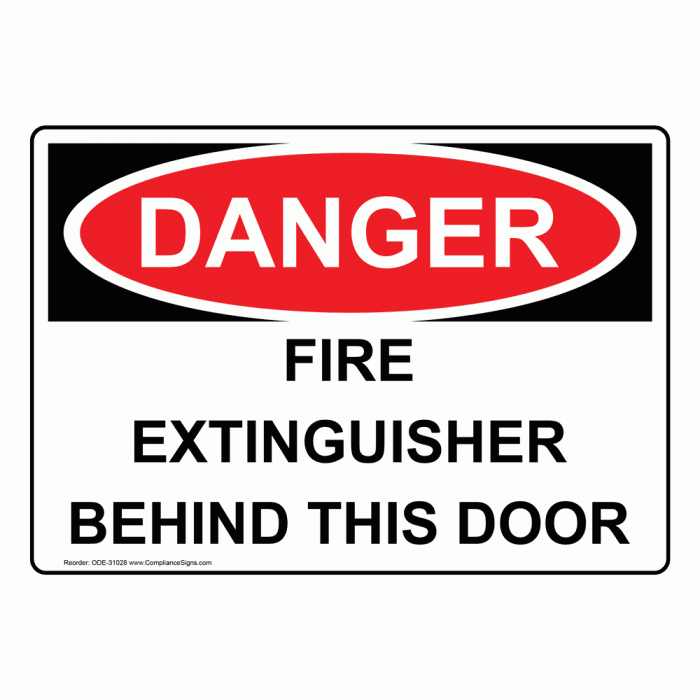
Source: compliancesigns.com
Effective fire extinguisher signage is crucial for quick and accurate identification during emergencies. Clear, concise, and universally understood symbols and wording are paramount to ensuring everyone can locate and use the correct extinguisher, saving valuable time and potentially lives. Poorly designed signage can lead to confusion and delay, hindering effective response to a fire.
Standardized Symbols and Pictograms
Standardized symbols and pictograms are essential for overcoming language barriers and ensuring immediate understanding, regardless of a person’s literacy level or native language. The use of internationally recognized symbols, such as those defined by ISO 7010, significantly improves the effectiveness of fire extinguisher signage. These symbols are simple, visually distinct, and readily understood across various cultures and backgrounds. For instance, the universally recognized symbol for a fire extinguisher depicts a red triangle containing a silhouette of a fire extinguisher. This simple image immediately communicates the location of fire safety equipment. The use of these standardized symbols eliminates any ambiguity and ensures that everyone can quickly identify the location of the nearest extinguisher.
Clear and Concise Language on Fire Extinguisher Signs
Using clear and concise language is just as vital as using standardized symbols. Avoid technical jargon or ambiguous wording. The text on the sign should directly and simply state the type of extinguisher and its location. For example, instead of “Class A Fire Suppression Device,” use “Water Fire Extinguisher.” Similarly, instead of a vague phrase like “Fire Safety Equipment,” specify “Fire Extinguisher.” The goal is to be unambiguous and instantly understandable. Overly wordy or complex language can lead to confusion and delays in critical situations.
Color Schemes and Their Impact on Sign Visibility
Color plays a significant role in the visibility and understanding of fire extinguisher signs. High-contrast color schemes are the most effective. A common and effective scheme involves using a red background (associated with fire warnings) and a white or yellow symbol and text. This combination ensures excellent visibility, even from a distance or in low-light conditions. Conversely, using colors that blend, such as dark blue text on a dark green background, drastically reduces visibility and effectiveness. The use of bright, bold colors like red and yellow immediately draws attention, making the sign easily noticeable in a potentially chaotic emergency. Subtle or muted colors, on the other hand, are less likely to be seen and understood quickly.
Examples of Effective and Ineffective Fire Extinguisher Sign Designs
Effective Sign Design Example: A bright red square sign with a clear white pictogram of a fire extinguisher and the words “FIRE EXTINGUISHER” in bold white letters. This design is easily visible, uses a high-contrast color scheme, and utilizes clear, concise language. The simple design avoids unnecessary complexity and ensures rapid identification.
Ineffective Sign Design Example: A small, dark green sign with faded yellow text reading “Class ABC Fire Suppression Unit – Location 3B.” This design uses a poor color scheme, making it difficult to see from a distance. The text is overly technical and ambiguous, lacking clarity and immediate understanding. Its small size also makes it less noticeable.
Accessibility Considerations for Fire Extinguisher Signage
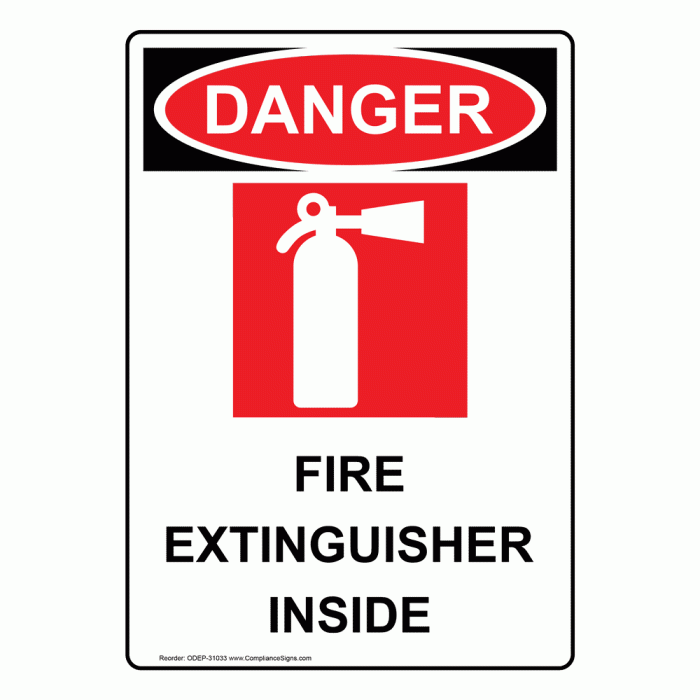
Source: compliancesigns.com
Creating accessible fire extinguisher signage is crucial for ensuring the safety of everyone in a building, including individuals with disabilities. Clear and easily understandable signage is essential for a swift and effective response in emergencies. Failing to provide accessible signage could have serious consequences, hindering a person’s ability to locate and use a fire extinguisher during a fire.
Accessibility for fire extinguisher signage primarily focuses on ensuring that individuals with visual impairments can easily locate and understand the information. This includes not only the location of the extinguisher itself but also instructions on its proper use. Compliance with accessibility standards is not just a matter of good practice; it’s often a legal requirement depending on your location and the type of building.
Tactile Signage for Fire Extinguisher Locations
Tactile signage uses raised lettering or symbols to convey information to people who are blind or have low vision. For fire extinguishers, this could involve a raised symbol of a fire extinguisher itself, accompanied by Braille text indicating its location and type. The placement of tactile signs should be consistent with the placement of visual signs, ensuring they are at the same height and easily reachable. Consider placing these signs directly above or below the visual sign, ensuring sufficient space to avoid accidental touching or covering. Tactile signage should be made from durable, weather-resistant materials to ensure longevity and readability. For instance, a raised metal sign with Braille could be affixed to a wall near a fire extinguisher.
Alternative Methods for Communicating Fire Extinguisher Information
Beyond tactile signage, auditory cues can be incorporated to guide visually impaired individuals to fire extinguishers. For example, a clear and concise audio announcement near the fire extinguisher could indicate its location and type. This could be part of a broader building-wide audio system, activated in emergencies, or a localized audio beacon triggered by a proximity sensor. Alternatively, a QR code linking to an audio file describing the extinguisher’s location and use could be placed on the visual sign, allowing users to access the information via a smartphone. This approach is particularly useful as it allows for more detailed instructions than would be practical on a tactile sign alone.
Font Sizes, Colors, and Contrast Levels
The design of visual fire extinguisher signs must ensure high visibility and readability for people with various visual abilities. Using a large, clear font size (at least 18 points) is essential, ensuring the text is legible from a distance. High contrast between the text color and the background color is crucial; for instance, using black text on a bright yellow background or white text on a dark blue background is more effective than using low-contrast combinations. Additionally, the use of universally understood symbols alongside text will further enhance accessibility, allowing for easier identification and understanding, even for those with low vision or cognitive impairments. Consider using bold text and simplified language to improve comprehension.
Final Conclusion
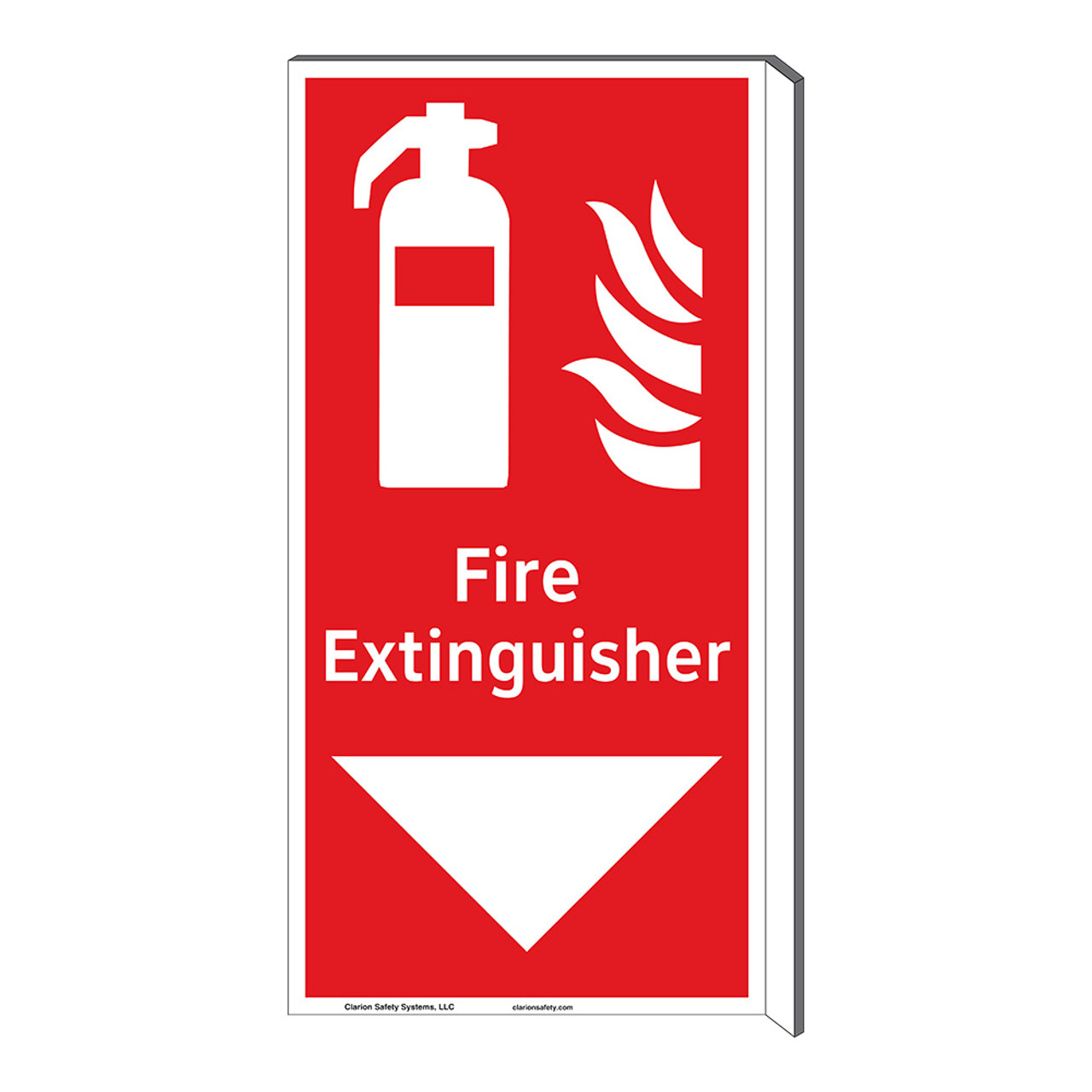
Source: bigcommerce.com
Properly installed and maintained OSHA fire extinguisher signs are not just a matter of compliance; they’re a critical element of a comprehensive fire safety plan. By understanding the regulations, design elements, and accessibility considerations discussed in this guide, you can create a safer work environment for everyone. Regular inspections and a proactive approach to sign maintenance are key to ensuring your signs remain effective and compliant, ultimately protecting lives and property.
Common Queries: Osha Fire Extinguisher Signs
What happens if my fire extinguisher signs are damaged or missing?
OSHA violations can result in fines and potential legal action. Damaged signs should be replaced immediately.
Are there specific color requirements for fire extinguisher signs?
While OSHA doesn’t mandate specific colors, using highly visible colors like red or yellow, with contrasting text, is generally recommended for maximum impact.
How often should I inspect my fire extinguisher signs?
Regular inspections, ideally monthly or as part of your overall fire safety inspections, are recommended to identify damage or fading.
What type of font is best for fire extinguisher signs?
Use a clear, easy-to-read sans-serif font in a size large enough to be easily visible from a distance.
Can I use homemade fire extinguisher signs?
While you can create your own, it’s best to use professionally made signs that meet OSHA standards to ensure clarity and legal compliance.
Comments are closed.